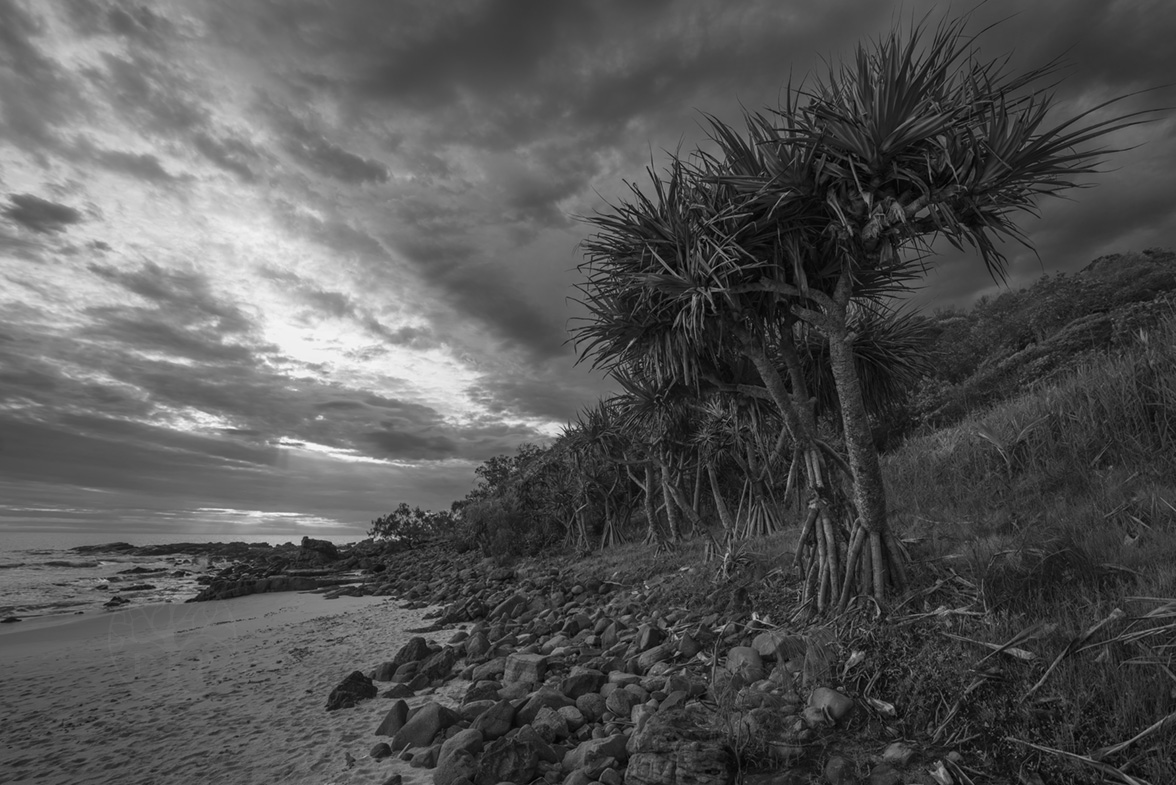I’ve been showing my good friend Erik Peterson of Bending the Arc Strategies around South East Queensland over the last week. Erik hails from a land of snow and pines, bears, moose and bobcats, so the subtropical environment and all its delights here have peaked his endless enthusiasm and boundless excitement. Erik is also a keen landscape photographer, and in the process of showing him around I’ve revisited many of the places where some of my iconic shots of the last two years have been taken.
One of these is Point Arkwright, a strangely deserted beach that sits at the foot of sprawling coastal urban development on the Sunshine Coast. There’s a fairly steep climb down to the beach from the headland above; even though that doesn’t seem to me to be sufficient an obstacle (especially for access to a stretch of scenery as remarkable as this), somehow it prevents most people from going down there. (ED: I have been reliably informed that this is actually because the beach is a nudist beach)
Which in a way is good. It meant Erik and I were able to arrive in the pre-dawn light and wander around in the zen-like reverie that is shooting landscapes (well, for me at least), without being disturbed or having our frames photo-bombed until well after sunrise. As we left the beach, it was still empty. Arkwright is a special place, and revisiting it has reinforced for me a couple of important concepts that guide my work. I’m pleased that these things are often born out in this way as I believe it underlines the essential truth in them, as well as the broader issues they suggest.
Without meandering too much, I’ll try to put these into words:
So, a few days before this shoot two other friends, John and Merri had both asked me, independently, the same question – basically:
“Where should I go to take really good landscape pictures?”
My first reaction was that it’s not about where you go, and it’s not about “taking” really good pictures…. well not initially, anyway. If you want to just take really good landscape pictures, then to my way of thinking, you’re missing half the point. Both times I probably mumbled something and didn’t really give either of them a full answer; I needed to think about it first. So I did. And this is what I came up with:
If you look at landscape photography as art, rather than the result of a set of skills and some expensive equipment, then the first question you should ask yourself is:
What do I want to say?
Art is essentially a form of expression, so that is the starting point for any piece of art. And once you’ve answered that, then you can start to think about where you want to go (and what time to go there) to find the visual elements you need to get your message across. I think that the way any given artist does this varies across a spectrum of the very literal to the instinctive. My good friend and one-time mentor Morten Hvaal for example, is a very literal photographer – possibly because of his background as a conflict journalist. But for me it is very non-literal – in fact a lot of the time I couldn’t tell you in words why I photographed something the way I did until after I had taken the shot, and the shooting process often involves lots of mulling around and head scratching, and a certain amount of swearing, at times. I guess it all depends on the type of conversations you have with yourself.
So, how did the early morning trip to Point Arkwright reinforce that for me?
Well, it came about because about a year ago I had come across some work by another photographer. It was panoramic landscape of a Sunshine Coast beach – it didn’t really speak to me but seemed to be just a pretty postcard picture (which is fine by the way). But something that jarred a little was the presence in the image of pandanus palms – as though that was an element that had to feature in the picture because it was there and because pandanus palms are a slightly iconic feature of beachscapes here. It jarred (I now realise) because the pandanus palm has a primordial feel to it (for me, anyway) that clashed with the postcard niceness of the image – they’re spiky and somewhat nasty-looking, being as they are a throw-back from an older, darker, time when the natural world was more violently aggressive and competitive. So from that time on, I avoided including them in any of my seascapes. It wasn’t until I noticed the row of pandanus palms on the beach at Point Arkwright that I felt that primordialness full-on, and began making pictures revolving around that theme.
Essentially, that brought home the idea that what I’m doing, or at least what I’m doing when I am producing my best work, is going to a place that I connect with deeply, and then expressing through my photos the visual concepts that make that connection. What I am not doing, what I have always tried not to do, and what usually leaves me with work I am dissatisfied with, is going to a place with the intention of taking or making “nice” pictures.
So to give John and Merri my full answer, it’s this: The only advice I can honestly give you is the same advice Morten once gave me:
“Start with what you want to say and work from there.”
The latter part of that instruction is relatively straightforward; knowing what the first part is is often harder.
Purchase Pandanus Storm Monochrome as a limited edition print here…

